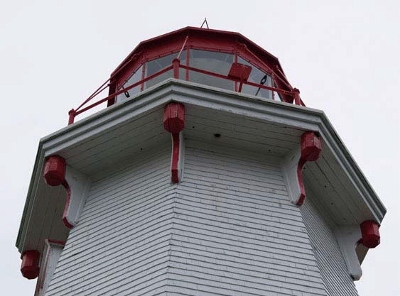Panmure Head Lighthouse
Heritage Lighthouse
Montague, Prince Edward Island

Detail
© Public Works and Government Services Canada | Travaux publics et Services gouvernementaux Canada
Address :
Lighthouse Road, Panmure Island, Montague, Prince Edward Island
Recognition Statute:
Heritage Lighthouse Protection Act (S.C. 2008, c 16)
Designation Date:
2015-02-12
Dates:
-
1853 to 1853
(Construction)
-
1853 to 1853
(Established)
Description of Historic Place
The Panmure Head Lighthouse is a 17.7 metres (58 feet) octagonal, tapered, wooden tower surmounted by a twelvesided, cast-iron lantern. It is located at the north end of a sandy beach on Panmure Island and marks the entrance to Georgetown Harbour on the east coast of Prince Edward Island.
Heritage Value
Heritage Value
The Panmure Head Lighthouse is a heritage lighthouse because of its historical, architectural, and community values.
Historical values
The Panmure Head Lighthouse is an excellent example of the development of marine aids to navigation along Canada’s coastal and inland waterways. Constructed in 1853, it was the second lighthouse built in Prince Edward Island. The lighthouse guides ships into Georgetown Harbour and keeps them clear of the dangerous Bear Reef
to the south.
The Panmure Head Lighthouse is an excellent example of the socio-economic development of the nearby coastal communities of Georgetown and Montague, which were shipbuilding and commercial centres. The lighthouse supported fishing boats, steamers, and schooners serving these communities and the surrounding
region. It also serves cruise ships heading towards the St. Lawrence, oil tankers servicing P.E.I. ports like Charlottetown, lobster and other fishing boats, as well as recreational traffic in the local area known as Three Rivers.
Architectural values
The Panmure Head Lighthouse is an excellent representation of an octagonal, tapered, wooden tower. It is visually
attractive due to its excellent proportions and decorative architectural features. In its form and decoration, the tower exhibits the traditional aesthetic favoured by early lighthouse designers.
The Panmure Head Lighthouse is exceptionally well built and over the years has required no major repairs, a tribute to its good craftsmanship and materials. The excellent functional design of its structure is reflected in its heavy timber-frame construction on a stone foundation.
Community values
The Panmure Head Lighthouse establishes the picturesque maritime character of the region, fitting comfortably in its surrounding marine and agricultural environment. As the tallest built structure visible from the water, it exhibits a certain domestic charm.
The Panmure Head Lighthouse is a symbol of the local community, being a major tourist attraction and icon for over 50 years. With its classic design, it has often represented Prince Edward Island in provincial tourist material. The lighthouse is well known to local residents and visitors, as it still serves its original purpose as a navigational aid for recreational, fishing, and commercial traffic.
Related buildings
No related buildings are included in the designation.
Character-Defining Elements
The following character-defining elements of the Panmure Head Lighthouse should be respected:
— its location at the north end of a sandy beach on Panmure Island;
— its intact, as-built structural form, height, profile, and balanced proportions based on the standard design of octagonal, tapered, wooden towers;
— its octagonal cast-iron lantern;
— its platform supported by scrolled brackets and surrounded by a metal railing;
— its tall octagonal wood-frame tower with tapered sides and a corbelled cornice;
— its six-over-six multi-paned windows;
— its sole entry doorway with red asphalt shingles pediment;
— its exterior walls covered with shingles;
— its simple interior layout with wooden ladder-type stairs;
— its traditional red and white exterior colour scheme, consisting of a white tower and gallery, with red features such as the trim of the door and windows, the railing of the gallery, the lantern, and the roof; and,
— its visual prominence in relation to the water and landscape.